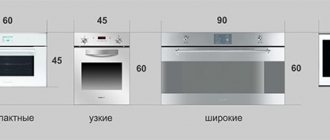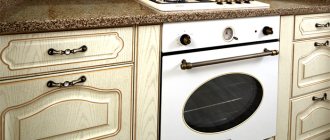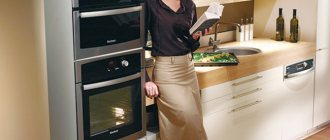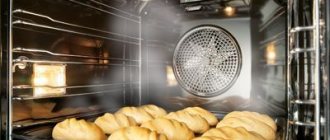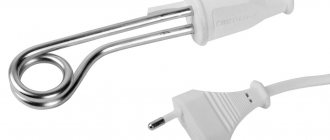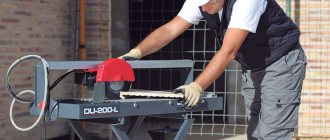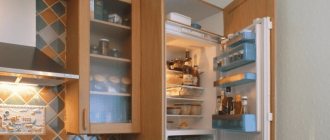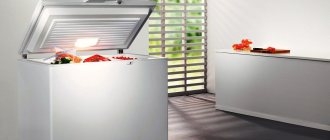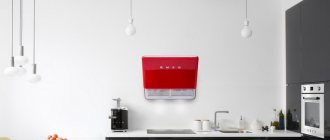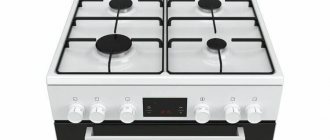Connecting the oven to the electrical network involves calculating the wiring parameters and automatic protective shutdown, which is due to the significant power of the device. The location of the outlet should be chosen correctly for ease of connection and safety. It is important to correctly place the built-in electric oven and take into account the presence of a hob.
Features of electric ovens and the process of connecting them
There are two types of electric ovens:
- dependent - in the same housing with the hob or complete with it. The entire structure has one control unit and is connected as a single device. Disadvantage: you need to think about the location taking into account the top plate. That is, the installation of the oven is limited in placement options - its top must be open. At the same time, connecting to the wiring is simpler, since such a device has one power cord;
- independent - separate self-sufficient products. You can purchase an additional hob for the device, but the devices will have separate control units and the same connection. This oven can be placed at a height to make it easier to observe cooking, or mounted in a cabinet with a closed top.
Construction of electric ovens
The main functional elements that determine the high power and complexity of connecting the oven to the network are heaters. Heating elements are used - metal tubes in the form of a coil, inside - filaments (spirals). Usually there are two heating elements in the inner chamber - at the bottom and at the top; some models also have additional elements on the sides.
For electric cooking surfaces, a different principle is often used - induction heating. High-frequency current is supplied to a coil of wire turns. Vortex processes are generated that convert energy into heat, heating a special surface.
The convection of air inside the oven chamber and the uniform distribution of heat flows is ensured by the impeller. Most models are additionally equipped with a tangential fan (casing with a wheel with blades), which simultaneously prevents heat leakage and overheating of the case.
Connecting an oven to electricity largely depends on the power, which is always significant, on average from 3.5 to 7 kW. If there is a hob, then you need to add the same amount.
Brand is a guarantee of quality. Is it so?
Of course, additional equipment for the oven is reflected in its cost. The price range also depends on other factors: the type of heating element, the timer model, the use of a catalytic coating of internal surfaces or the pyrolytic cleaning function of the oven, as well as the design of the front panel.
The quality of any household appliance is determined by its durability, reliability and safety in use. Electric ovens are not the most complex technical designs, but their quality also determines the level of culture in our everyday life. It follows from this that it is still better to purchase not simplified cheap models, but products from manufacturers with a time-tested reputation. Well-known brands Bosh, Gaggenau, Neff or Miele, Siemens are a kind of sign of the quality of equipment that facilitates everyday worries about comfort in the home and food on the table.
Electric ovens produced under these brands will last for many years and, if used correctly, will not cause any hassle with repairs or forced replacement. They are quite expensive, but if you buy high-quality multifunctional kitchen equipment, there will be no need to spend additional money on equipment that duplicates the functions already included in it. For example, a set of a gas stove and an electric oven with a microwave function from Bosh will fully satisfy the need for equipment designed for heat treatment of products; There is no need to buy a microwave or gas oven.
In addition, the design developed by one company will harmoniously appear in the appliances of the general line if they are selected in accordance with a certain style of design of the kitchen or dining area.
What to consider when connecting the oven to the electrical network
Parameters that must be taken into account and assessed before installing the oven and connecting it to the network:
- ratio of power and wiring: two- or three-phase (for a 220 or 380 V network), cross-section of conductors, whether there is grounding;
- automatic protective shutdown parameters (circuit breakers, RCDs or automatic circuit breakers);
- location and parameters of sockets: they must be at a safe distance, suitable for the current value;
- size of the electric oven, whether a hob will be installed.
Oven device
In order to choose good heating equipment, you need to understand the principle of its operation. And, at least to a minimum, be aware of the quality of the materials from which the cabinet elements are made.
The external part of the device consists of the housing, door, switches, controls or touch panel. When choosing, special attention should be paid to inspecting the door. It consists of stainless steel and glass. And on the inside there are special rubber linings. When closed, they fit tightly to the base, and a sealed space is created inside the cabinet. So, you need to check how tightly the cabinet closes. In this case, the door should function at “five plus”. That is, it does not creak, opens and closes easily, without effort. The handle on the door should be trimmed with a plastic element. It does not heat up, which is safe during operation.
Floor and tabletop products have legs or wheels. They are made of durable plastic. There are also burners on the upper horizontal part. If the model is without a hob, there are no burners.
The interior of the oven is equipped with heating elements at the top, bottom and middle. There is also a fan and special holes installed for uniform heat distribution.
Ovens have very poor convection. That is, heated air cannot pass from bottom to top. Chefs often encounter a problem where the bottom burns but the top remains undercooked. But competent technologists and developers of thermal equipment found a way out of this situation. They created a built-in convection system, the main element of which is a fan. Most modern oven models are ventilated. And it is recommended to choose just such a device.
All modern cabinets have a grill mode. It is ensured by the simultaneous sharp heating of several heating elements. You can cook meat, fish dishes, as well as chips or croutons on the grill.
The inner surface of the chamber is made of stainless steel. And on top it is coated with a special polymer composition. This protects the elements from corrosion and deformation when heated.
Wiring
In old buildings (Soviet period), if the wiring has not been changed, then it is aluminum, with a core cross-section of 1.5 mm², without a grounding wire. According to some tables of ratios, it is believed that this is enough for 4.4–5 kW, but in practice for such powerful appliances as an oven this is enough for 3.5 kW and no more. You will have to either change the line or select a device with a lower capacity (up to 3.5 kW and 16 A), otherwise there is a risk of overheating of the wires and fire.
Often the rules are violated and, for example, 5 kW devices are “hung” on an aluminum line of 1.5 mm², and they work for years without negative consequences, but this is a risk and there is no guarantee against overheating of the cores. Before installing a built-in oven, it is advisable to study several options for tables of power ratios and wiring cross-sections. Select the average value (in most cases this is enough) or with a margin.
You must connect the oven to the power supply taking into account the wiring rules:
- The power of the consumers is summed up, so it is advisable to allocate a separate line with one socket for the electric oven. However, if the cross-section of the cores allows, then more consumers are allowed, but it must be taken into account that in the event of an overload, short circuit, or breakdown, all devices will be de-energized. And also the differential current values for shutdown are different for individual devices, so incorrect operation of the protection is possible;
- automatic protective shutdown - RCD, difavtomat - highly desirable. But if there is no grounding (two-wire wiring), then it is mandatory. Without protection in the event of a breakdown or insulation failure, the user risks receiving an electric shock with fatal consequences, and in the event of a voltage surge, the risk of device failure is increased;
- It is necessary to select not only the cross-section of the conductors, but also the parameters of the sockets according to the current value, otherwise they will heat up and there will be a risk of fire.
Heating method - gas or electricity
This is the first and main choice that will have to be made. Mainly, which oven to choose depends on where it will be used, as well as on gas and electricity prices in a particular region. That is, you need to know what capabilities and communications your premises have. Additionally, it is necessary to take into account the functionality of the devices - electric ovens in this regard are significantly ahead of gas-powered devices. It also happens that you simply don’t want to retrain, because your hand is already “stuffed” to work with a certain type of device.
Features of gas ovens
Gas ovens can operate on both natural and liquefied gas.
Most often they have only one burner, which is located at the bottom. Some models have a grill in the upper part, but there are very few of them. This detail complicates the design and requires additional thermal insulation - the gas from the grill nozzles does not come out downwards, but to the sides and upwards, transferring almost half of the heat to the oven body.
Such devices do not have automatic temperature control - you need to get used to each oven separately. If you often cook dishes that require maintaining a certain temperature, then you will have to buy a thermometer for a gas oven. For the same reason, such devices are quite poor in functionality - automation simply cannot carry out precise manipulations with mechanical gas supply regulators.
Also, if used frequently, it is advisable to provide a good exhaust hood to the oven - when the oven is operating, carbon monoxide will accumulate in the air, which can cause headaches.
The main advantages of gas ovens are their economical use and the ability to use them in places where there is no electricity - this is an ideal option for a summer house, where you can connect a gas cylinder and cook.
Electric ovens
Apart from the relative high cost of operation and the impossibility of autonomous use, these devices have no disadvantages. Heating elements can be located on the top, bottom and side, which allows you to heat the prepared dishes more evenly. Maintaining the desired temperature occurs by turning the heating elements on and off, which is freely implemented even in budget models.
The absence of open fire means better fire safety and expanded functionality including, for example, convection heating, which is quite difficult to implement in gas stoves.
The most functional models are equipped with a steam generator and magnetron, which allows you to combine an oven, steamer and microwave oven in one housing.
Considering that the average family uses the oven two or three times a week, energy costs are unlikely to increase much. Coupled with wide capabilities and ease of use, this makes electric ovens the undisputed leader in the market, gradually replacing gas-powered models.
Sockets
The socket must be designed for the power of the devices and network parameters. They select according to the current value - for example, if the wiring cross-section is for 16 A, which is suitable for an electric oven with 3.5 kW, then you need a model specifically for this or a larger characteristic. In this case, if you take such a product for 16 A, then it will be enough, so you can put it at 20 or 32 A.
Sockets for high currents may differ in shape and holes; often the plug of the electric oven cord has a geometry for them, for example, for 32 A - three flat terminals. If the network is three-phase, then a product with 4 or 5 wires will be required. If the calculations are incorrect, the outlet will heat up and burn out may occur. Old Soviet models will not definitely fit - they are 6 A. You need to choose starting from type F and 10 A. For greater safety, you can choose a waterproof size with a lid (for example, IP 44 from splashes).
Socket placement
It is recommended to install the socket at a height of 30 cm from the floor for safety in case of flooding. Usually it is placed no higher than 1 m (SP 31-110-2003 clause 14.35). It is not advisable to install it under or above heating devices and boilers.
Approximate recommendations for distances: to window openings - at least 10 cm, door openings - 60, from the boiler tank, oven heating chamber - 60.
All advice on how to properly install an outlet is not specific and of a recommendation nature, but it is important to at least approximately take into account the rules and the appropriateness of the placement option. For example, it is reasonable to provide a gap of 10–30 cm from the floor for safety in case of flooding.
The optimal height of sockets under normal circumstances is not lower than 90 cm (eye level), according to the European standard - 30 cm. In conditions of limited space and technical features of the kitchen, the rules may not be followed. But it is always important that the socket is not directly under or above the devices, but on the side, behind, in areas that are as protected as possible from heat flows and splashes. Often kitchen furniture does not have a back wall, so the socket is hidden there.
Popular oven models
When buying an oven, many people first of all look at the cost. It is important to understand that the price depends on the brand and functionality. Products from popular manufacturers will cost more than equipment from a little-known brand. But if you approach the search for an affordable option wisely, you can buy a completely reliable device that will not be inferior in quality to branded samples. It is recommended to read user reviews before purchasing. Only then select a model that suits your characteristics.
Let's name a few economical ovens for business:
- Electrolux. There are modifications on the market that cost from 15,000 rubles. For example, model 52410 AK is quite suitable for a small coffee shop. Its volume is 60 liters, dimensions 59 by 56 by 59 cm (width, depth and height). Compact equipment, easy to use. Can be installed on a special shelf or table. And if possible, even build it into the wall. There is a convection system, fast and uniform heating. If you need to reheat baked goods, the cabinet will do the job perfectly in a matter of minutes. Pay attention also to these models of the Electrolux brand: AX, AW, 55420AK. Their cost is from 15 to 20 thousand rubles. An excellent option for a start-up business.
- Schaub Lorenz. The cost of these cabinets starts from 20,800 rubles. The volume is similar to the previous one, the volume is 61 liters. Independent control method. Six heating modes. Hydrolysis type cleaning. Convenient mechanical switches using the rotary method. Grill, convection, low electricity consumption. A completely suitable brand for small and medium-sized businesses.
Among the best manufacturers of heating equipment, which are better known to consumers, are these: Abat, Atesy, Gomeltorgmash. The first two brands are domestic. Their models ShZhE-3-K and EShV-3 enjoy excellent reviews. And Gomeltorgmash is a Belarusian company that has long and firmly taken a leading position in the heating equipment market in Russia. Ovens from these manufacturers can be purchased at different prices - from 20,000 to 100,000 rubles.
For a larger enterprise, you will need to install a large cabinet, the price of which will be appropriate. But such equipment is often purchased for establishments where the priority dish is baked goods, for example, in large canteens, restaurants or bakeries.
Among the expensive brands are these:
- TEKA EBON. The price starts from 42,000 rubles. German production. Touch control type and 10 operating modes. Volume 57 liters. The cabinet can switch off automatically. That is, there is no need to control the baking process - the unit will turn off itself at the set time. The inner glass of the door is removable. It is convenient to care for such equipment.
- Tecnoinox is an expensive combination model. Two in one: stove and oven. This pleasure costs about 140 thousand rubles. Suitable for establishments that cook a lot and often. But this is gas equipment. Floor type installation. Made from high quality stainless steel. Optimal safety class.
- FORNELLI FET, costs 77,000 rubles. Electric oven made in Turkey with six operating modes. This is a built-in device. Equipped with all modern features: convection, grill, automatic shut-off, backlight, convenient control.
Oven Abat ShZhE-1-01
Oven with gas stove Technoinox
Cable
If, when purchasing an oven, a cable with a plug is included, then it is already designed for the power of the device. But often there is no power cord, and this situation is standard, since different connection options are used and the cable that will be included may turn out to be unnecessary.
Cable selection:
- for low-moving wiring from the panel (open or in a groove) to the socket hole or outlet - monolithic cable VVGng (NYMng);
- The oven may be portable, meaning movable segments of the power cord (from the outlet or wiring) may be required. For such areas you need a multi-core cable. Although monolithic can also be used: it is usually copper, has a certain degree of flexibility and is less prone to fractures, unlike aluminum. Here the user must evaluate the frequency of movement of the electric oven. PVA is suitable for the role of stranded wire.
Additional devices and options
We have figured out the variety of types and types of ovens, but this is not enough to choose an oven model, since there are a huge number of additional options that each manufacturer strives to increase. Let's look at some of the common options offered by manufacturers.
Convection
Convection is a heating mode in which hot air circulates throughout the oven. The convection heating mode of the oven is ensured by the operation of a fan located on the back wall of the oven
closet Thanks to convection, you can cook dishes on several levels at the same time and you don’t have to worry about baking evenly.
Grill
A grill is a gas, electric or infrared heating element located in the upper part of the oven that radiates heat in such a way that the food underneath quickly browns on top, while remaining tender and juicy inside.
Skewer
A spit is a device, often equipped with an electric motor, that allows you to cook barbecue or large pieces of meat, fish, and poultry by baking them evenly on all sides.
Oven with microwave function
The microwave function is the ability to use the oven as a microwave oven, and it is possible to combine it with other operating modes, such as grill and conventional. When using the microwave function, the cooking process is significantly accelerated. Read more…
Electric ignition of gas ovens
Electric ignition is a device that ignites the flame of gas burners without opening the oven door using an electric spark, which ensures the safety and convenience of using the oven. Electric ignition can be implemented automatically when switching the gas burner adjustment or as a separate button.
Telescopic guides
Telescopic guides are retractable runners on which baking sheets are placed. There are implementations of telescopic guides that extend out of the oven simultaneously with the opening of the door, which ensures the safety of checking the readiness of the dish and the convenience of using the oven, but the most common implementation is one that does not extend when the door is opened, but this simple design is very convenient to use, since there is no need to remove the baking sheet from the oven runners.
Timer
A timer is a device for programming time that allows you to timely control the degree of readiness of a dish and turn off the oven in a timely manner. There are models with an audible timer that only beep when the time has elapsed, and there are models with the oven automatically turning off.
Ability to program
There are models with a specific list of programs provided by the manufacturer, which allows you to automatically prepare various dishes or perform the operations necessary for their preparation, such as defrosting. There are also models that allow you to create your own cooking programs and save them in memory.
Tangential mechanism
A tangential mechanism is a mechanism that uses a cooling fan to supply cold air from the bottom up through the door's supply duct system to cool it by displacing heated air through an air duct located above the door, which also prevents the kitchen unit from heating up.
Pyrolytic cleaning
Pyrolytic cleaning is the most effective high-temperature automatic oven cleaning system, in which dirt burns, turning into ash, thereby eliminating the need to use special detergents, but not a damp cloth. Read more…
Catalytic purification
Catalytic cleaning is a system that uses fine-pored enamel with catalytic properties to accelerate the oxidation of fat and its breakdown into water and carbon. Unlike the pyrolytic cleaning system, in the catalytic system cleaning occurs during the cooking process at a working temperature of up to 200-250°C, but this does not eliminate the need to clean the working chamber with special means, but only reduces the frequency of their use. Read more…
We have provided only a small part of the most common and popular additional functions and options offered by manufacturers. At the same time, each manufacturer has its own unique options and functions offered to customers, which you can familiarize yourself with in the relevant sections:
- Popular models of Bosch ovens
- Popular models of Gorenje ovens
Electrical connection
Connecting an electric oven can be done in two ways:
- directly to the wiring from the panel;
- power cord with plug to the socket installed on the line.
The two methods are equally effective, but with nuances that affect the comfort and maintenance of the oven. With direct installation, installing the network connection of a built-in oven with your own hands is done using mechanical methods: twisting, bolted and terminal structures.
The disadvantage is that it is difficult to disconnect the device, for example, if you need to move it during maintenance or cleaning. Direct connection is used, for example, for aesthetic or technical reasons.
Connection through an outlet is used more often; the option is more convenient. Even if there is no suitable outlet, buying one with the required current parameters (for example, 10, 16, 32 A) and connecting it to the wiring will not be difficult.
Electric oven with hob or other consumers
Electric ovens are powerful (3.5–5 kW), but hobs are even more power-hungry (5–7 kW), so when connecting these two separate appliances, significant adjustments must be made when assessing wiring capabilities. This also applies to situations when other devices are simultaneously powered through one line - lighting, boilers, kettles, etc.
In most cases, the current consumption of the oven is up to 16 A, and if it is powered through the same machine with other devices, then an overload and a shutdown may occur. For example, if you simultaneously connect an electric kettle with 6.5 A, which gives a total of 22.5 A, the automatic protection system will turn off two devices.
It makes more sense to connect an electric oven by extending a power line (for an average appliance, a cross-section of 2.5 mm² is sufficient) only for it with an individual protective automatic shutdown from the input switchboard. You can also use an existing line if it fits the parameters, but do not “hang” other consumers on it. The same applies to the standard size cabinet + hob in the format of a solid appliance with one power cord.
It is not necessary to make grooves for a separate line - it can be done openly, hiding the cores in plastic boxes.
Ovens of a dependent type (the hob is built-in) or separate such devices on the same line (this is not desirable, but is allowed if the wiring is suitable) will together consume a lot of electricity - from 7 kW. You will need at least conductors with a cross section of 4 mm², if the wires are aluminum - then from 6 mm².
Features of connecting a separate electric oven and hob
The cross-section of the supply wires for devices purchased separately and not as a whole device may be different. For a cabinet, a smaller value is usually required - 2.5 mm², for a stove - 4 mm². For a hob, you will need an AB with a rating of 25–32 A under 4 mm²; for a cabinet, 16 A is enough. A higher value is always selected. Accordingly, if the oven malfunctions, the AB will not work; shutdown will occur only when all the insulation burns out and a short circuit occurs.
Kinds
Thanks to the wide variety of thermal equipment, a person can choose the optimal, convenient and productive model for himself. So, let’s look at the classification of ovens.
They can be divided according to the following principles:
- by heating methods: gas and electric;
- by size: one, two, three sections;
- by installation methods: built-in, floor-mounted, tabletop;
- by management methods: dependent, independent.
Gas and electric
Depending on the heating methods, gas and electric cabinets are distinguished. The first option is gradually becoming a thing of the past. Gas ovens are often used at home or in small catering establishments. Modern entrepreneurs prefer electrical engineering. Despite the fact that you have to pay for electricity. Why is that?
Firstly, not all Russian territories are equipped with gas pipelines. This is a difficult, serious and expensive method. If gas is already supplied to the premises you rent for a coffee shop or cafe, there will be no problems. If not, give preference to electrical equipment.
Secondly, gas appliances have a significant drawback: uneven heating. But this problem can be solved if the cabinet is equipped with a fan that will distribute the heat over the entire area of the cabinet.
Electric ovens have many more options. This expands the capabilities of the equipment. Such units provide accurate and stable temperatures that you can regulate. The large presence of different functions makes electrical cabinets functional and more convenient for industrial applications. There are models with hobs. This is a great option for a coffee shop.
Electric oven
One, two and three-section
Based on their dimensions, ovens are classified into one, two and three sections. A section means a special device on which the grilles are installed. 3-4 gratings can be placed on one level.
Depending on the number of sections, the dimensions of the cabinet vary. It is important to understand that the smaller the internal volume, the faster the chamber heats up. But at the same time, you cannot bake a large number of buns. Therefore, before you decide how many sections you need, think about the planned scale of your cooking.
For a small establishment, there is no need to buy a three-section cabinet. And, conversely, if there are a lot of customers, you will have to cook or bake more. Keep in mind that smaller appliances are easier to clean. And, if necessary, such an oven can be moved to another place.
Single-section floor oven with shelf for dishes
Three-section oven
Built-in, floor-standing and tabletop
Depending on the installation method, there are table-top, floor-standing or built-in cabinets. Desktop models are rarely purchased for business. These are small cabinets with minimal functionality. They are recommended to be installed in establishments with low traffic or in those cafes where baking is not a priority dish.
Floor-standing ovens are often purchased for catering establishments, restaurants and coffee shops. Despite the fact that this equipment is large and takes up a lot of room space, it has a significant advantage: high performance. There are a lot of dough pieces placed inside. When choosing, it is important to consider whether the floor oven has wheels. They make life easier - such a cabinet can be moved without resorting to outside help.
However, floor-standing devices are more expensive. But for a coffee shop, cafe or restaurant with average traffic, this is the most suitable option.
Built-in models appeared only a few years ago. They are inserted into a prepared niche in the wall. It is very ergonomic and convenient. If there is little space in the room, it is recommended to purchase such a cabinet. They come in different sizes. With innovative control systems.
Tabletop oven
Floor-standing three-section cabinet with wheels
Dependent and independent
Depending on the control methods, ovens can be dependent or independent. Let's figure out what this means.
In dependent types, the oven and the cooking panel represent one complete system. They are mounted in one housing. And control is carried out from the same panel. However, not everyone likes dependent devices. Many users find them inconvenient.
Dependent ovens can operate as one system, which includes a large number of burners and 2-3 or more oven cabinets. This is a fairly large block of heating equipment, which is suitable for large catering outlets (canteens, restaurants with banquet halls).
Independent modifications have a separate control panel. It can be built in or installed separately. It is convenient to use such equipment in cases where it is built above the table. A person does not need to bend over to track the cooking process. And the control panel can be placed wherever it is convenient.
Both oven options are suitable for a coffee shop. Here you should take into account your own preferences and evaluate the possibility of placing equipment.
Dependent oven with hob and shelf for kitchen utensils
Heating unit with 2 ovens and 6 hob burners
Connecting wires
All manipulations when connecting wires, installing automation, sockets, wiring are carried out with the circuit breaker turned off (in the switchboard it must be clicked into the off position).
An example of creating a power cord. If there is an outlet and the electric oven has a power of up to 3.5 kW (can be marked P = 3.5 kW), then it is enough to buy a piece of PVA 3 × 2.5 and a collapsible plug for it for 16 A. The length can be selected according to needs, the main thing is that there is no tension.
In the plug, the yellow (yellow-green) wire goes to the ground connector, brown (phase) and blue (zero) are connected to the rest. At the same time, for household appliances, polarity does not matter, but it must be taken into account when connecting wiring to the switchboard, automation (L - phase, N - working zero). "Earth" (PE) must always correspond to its place in the plug and terminals.
Additional functions for the electric oven
The grill is not a necessary element for the functioning of the oven, but thanks to it, an appetizing chicken or goose with apples is covered with a golden crispy crust that will not leave anyone at the table indifferent. This same crust will be uniform if the oven is equipped with a spit, and its diagonal arrangement will allow you to cook more portions if you need to bake a chicken leg, cook a shish kebab or brown steaks. Convection is another additional feature that simplifies the cooking process on two or three levels. The circulation of heated air promotes uniform heating and baking of dough products, and in this case meat dishes turn out juicy and tender. You can check the degree of their readiness using a special sensor - a temperature probe, which is included as an additional element in the package of some models of high-end ovens. A function using it is necessary if it is necessary to strictly maintain the temperature range corresponding to the cooking technology. Return to content
Connection instructions step by step
The procedure for connecting an electric built-in oven to electricity by creating a separate line:
- The input AV switches off in the switchboard.
- Automatic protection is connected.
- The line cable is pulled to the panel, it should be connected there to the RCD or RCBO.
- Next, observing the polarity, connect the wires to the outlet box, if the oven has a cord with a plug, or directly to the power cable of the electric oven, to its terminals.
Technical capabilities of autonomous and dependent cabinets
The control system in ovens powered by electricity can be autonomous or dependent. In dependent models, control of the oven functions is included in the overall system of the electronic or mechanical hob. The oven is connected to the overall structure of the stove by simply pressing a button, which has only two modes: on and off. Autonomous models are equipped with a separate control panel, on which there is a symbolic designation of the functions included in their technical characteristics. If kitchen appliances are purchased as a set, it is more profitable to buy a dependent model, because its cost will be partially included in the cost of the stove. As a rule, ovens and stoves from leading European manufacturers enter the consumer market precisely as complementary elements of kitchen equipment. If the oven is needed as a separate electric heating device, you should choose a model of the same brand and class as the stove, otherwise the functions of the hob may not coincide with the technical capabilities of the oven itself. Choosing an oven with autonomous control will eliminate such problems. Its panel is located on the front of the structure and contains exactly those options that correspond to its functionality. Such cabinets are much more expensive, but their advantages are obvious. Return to content
Where can I buy
You can purchase equipment as quickly as possible at your nearest specialized store. The optimal option, in terms of price-quality ratio, remains purchasing from the AliExpress online store. Mandatory long waits for parcels from China are a thing of the past, because now many goods are in intermediate warehouses in destination countries: for example, when ordering, you can select the “Delivery from the Russian Federation” option:
| Electric convection oven AVEX, display, 7 functions | Electric oven HIBERG | Electric fish smoker BEIJAMEI |
| Intelligent Air Fryer, 1200 W | DKX60-01 built-in electric oven with Smart Touch\ | ITOP Double Layer Baking Oven |
Useful innovations
A convenient innovation in the latest generation of electric ovens is a retractable trolley. It extends automatically if there is a need to open the oven door to determine at what stage of cooking its contents are. You don’t have to pull out the baking tray with a potholder, risking getting burned or ruining the appearance of the dish: it’s very convenient, although it’s not cheap.
The disadvantage of electric household appliances, especially ovens, is that their body gets very hot during operation. Models equipped with a cold air wall blowing system completely eliminate this problem. The same goal is pursued by installing double or triple glass in the oven door.
An oven with a microwave function is both an oven and a microwave oven. This is convenient in all respects, including in terms of zoning the kitchen space.
